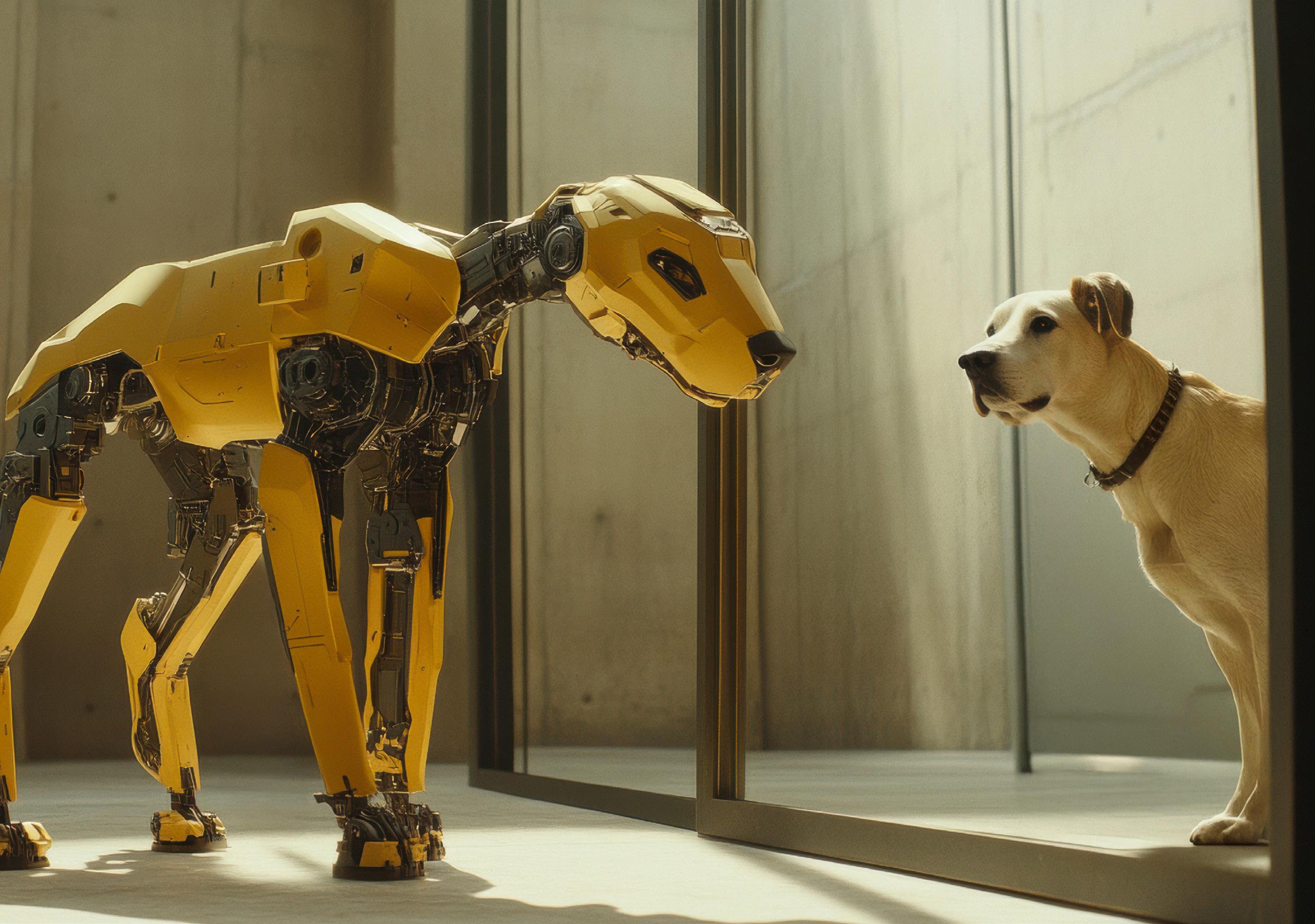Teaching robodogs new tricks

Modelled on the neural control systems of animals, a new layered control framework enables legged robots to navigate complex terrains with greater agility and precision.
Eyes on the finish line. The whistle blows. A trained canine whizzes past obstacles, swerves around bright orange cones, leaps through metre-high hoops and glides effortlessly under low bars as the spellbound audience oohs and aahs in unison.
Issue 04 | January 2025 Forging New Frontiers

Agility championships are a showcase of how nimble and acrobatic dogs can be. Assistant Professor Guillaume Sartoretti is training agile dogs of his own. But not the furry kind; rather, those that take a sleek, metallic form.
At the Department of Mechanical Engineering, College of Design and Engineering, National University of Singapore, Asst Prof Sartoretti and his team, in collaboration with researchers from the École Polytechnique Fédérale de Lausanne (EPFL) in Switzerland, have designed a robotic control framework that emulates the central nervous system’s layered approach to movement control. This equips quadruped robots with the agility and adaptability needed to grapple with complex terrains. The team’s work also deepens our understanding of the biological principles that drive animal movement.
The team’s findings were published in the preprint repository arXiv on 27 April 2024, and later presented at the IEEE/RSJ International Conference on Intelligent Robots and Systems, one of the top conferences in the field, in Abu Dhabi in October 2024.
Learning from nature
Traversing unpredictable, obstacle-laden terrain with ease is second nature to many vertebrates — thanks to the wonders of the central nervous system (CNS). For locomotion, the core of this system are the central pattern generators (CPGs) — networks of neurons in the spinal cord that generate rhythmic muscle movements even without direct orders from the brain. This provides the basis for essential actions such as walking, running and climbing.
To handle and adapt to complex environments — such as obstacles, changing surface textures, or sudden shifts in direction — animals depend on descending modulation, which are signals from the brain that tweak the CPG-generated rhythm based on sensory feedback. Visual cues, balance and touch provide immediate data, enabling animals to make split-second adjustments to their movements. This multi-layered, feedback-driven system is what makes animals so adept at moving across various terrains, from rocky paths to steep inclines.
Issue 04 | January 2025
Robodogs, however, are not trained to match this natural versatility. Traditional frameworks that control their movement are single-layered and perform well in simpler environments, but stumble when presented with stairs or uneven ground. Newer models, while slightly better at rhythmic movement, lack the finesse required for rapid, real-time adjustments in rough terrains.
To bridge this gap, Asst Prof Sartoretti’s team looked to nature for inspiration. Their hierarchical control system emulates the CNS of vertebrates using two distinct neural networks to handle movement.
“The first network is like the spinalcord CPGs in animals, where it produces basic rhythmic gaits that enable the robot to walk and maintain balance on flat terrain,” says Asst Prof Sartoretti. “Meanwhile, the second, or descending modulation network, takes in sensory data from the environment, using inertial and joint sensors, as well as a visual sensor, to adjust the robot’s movement as needed — much like how animals use their senses to fine-tune their actions.”
Together, these layers enable the robotic system to react dynamically. Simulations have demonstrated the robot’s ability to navigate environments with stairs, high obstacles and wide gaps, maintaining coordinated movement and avoiding missteps.
“The first network is like the spinal-cord CPGs in animals, where it produces basic rhythmic gaits that enable the robot to walk and maintain balance on flat terrain.”
Training ground
The team’s work also uncovers fresh insights into the biological principles governing animal locomotion. “With the support of the EPFL team, we’ve further underlined how the CNS’s layered control — balancing rhythmic movement with adaptive feedback — provides stability and agility in animals,” adds Asst Prof Sartoretti. “For instance, robustness to sensorimotor delays — kinks that make current robotic systems stumble in unpredictable environments — has been widely documented in animals, but this is the first time it has been studied and replicated in robodogs.”
04 | January 2025
This means robodogs could be trained to do much more, particularly in challenging, high-stakes environments. For instance, disaster relief often relies on rescue dogs to explore collapsed buildings and rubble in search of survivors. Autonomous robots could scale up these efforts, critical in the first hours after a disaster, while reducing risks to human and canine rescuers. More generally, legged robots could play a role in last-mile delivery, scaling stairs to deliver packages to doorsteps, or serving as home assistants to help older or less-able individuals with daily tasks and chores.
The team’s next steps involve refining how the two control layers interact, allowing for real-time adjustments in rhythm, reflexes, and even gait transitions, such as switching to running or carefully stepping over obstacles — a feat yet to be achieved in robotics. They are currently wrapping up tests of their bio-inspired framework on actual robodogs to gauge its reliability and adaptability in realworld settings.
Turns out, you can teach an old dog new tricks — especially if it’s made of metal.
